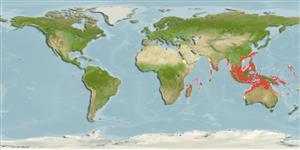分類 / Names
共通名の | 類義語 | Catalog of Fishes(部類, 種) | ITIS | CoL | WoRMS | Cloffa
板鰓亜鋼(サメとエイ類) (sharks and rays) >
Carcharhiniformes (Ground sharks) >
Hemigaleidae (Weasel sharks)
Etymology: Hemigaleus: hemi-, from hemisys (Gr.), half, referring to similarity to and/or close affinity with Galeus (now in Pentanchidae) (See ETYFish); microstoma: micro-, from mikros (Gr.), small; stoma (Gr.), mouth, referring to very short arched mouth compared with Chaenogaleus macrostoma, its presumed congener at the time (See ETYFish).
More on author: Bleeker.
Issue
Specimens from Australia (and probably Papua New Guinea) are placed in Hemigaleus australiensis White, Last & Compagno, 2005 (Ref. 56150).
Environment: milieu / climate zone / depth range / distribution range
生態学
海 底生の. Tropical; 22°C - 28°C (Ref. 244); 28°N - 30°S
Indo-West Pacific: southern India and Sri Lanka; China to Indonesia (Ref. 56150). Also from Red Sea (Ref. 93009).
Specimens found in Australia (and probably Papua New Guinea) belong to a separate species, Hemigaleus australiensis (Ref. 56150).
Length at first maturity / サイズ / 重さ / 年齢
Maturity: Lm ?, range 78 - ? cm
Max length : 135 cm TL オス/雌雄の選別がない; (Ref. 130455); 最大公表体重: 14.0 kg (Ref. 130455)
背面の脊椎 (合計) : 0; 肛門の骨: 0. Australian specimens with dark-tipped fins; tooth counts 28-34/43-54; total vertebral counts 111 to 118 (Ref. 13567). Indonesian, Singapore and Thailand specimens with light-tipped fins; tooth counts 25-32/37-43; total vertebral counts 137 to 150 (Ref. 13567). Grey-brown above, lighter below, dorsal fins with white tips and posterior margins, sometimes with spots on sides of body (Ref. 13567).
A small, relatively common inshore and offshore shark of tropical continental seas (Ref. 13567). Feeds mainly on cephalopods, particularly octopi (Ref. 13567) but also takes crustaceans and cephalopods (Ref. 244). Viviparous (Ref. 50449). Taken regularly in inshore artisanal fisheries (Ref.244), commonly caught by inshore gillnet, bottom trawl and, to a lesser extent, longline fisheries. Utilized for human consumption (Ref. 244). Offal used for fishmeal (Ref. 244).
Life cycle and mating behavior
成熟 | 繁殖 | 放精 | 卵 | 生産力 | 幼生
Viviparous, with a yolk-sac placenta; 4 to 14 fetuses in a litter (Ref. 13567); 2-4 pups after a gestation period of about 6 months; born at about 45-47 cm TL (Ref. 58048). Size of full-term fetuses (detached umbilical cords and placentae) ranges from 23.7 to 25.6 cm (Ref. 244). Distinct pairing with embrace (Ref. 205).
Compagno, L.J.V., 1984. FAO Species Catalogue. Vol. 4. Sharks of the world. An annotated and illustrated catalogue of shark species known to date. Part 2 - Carcharhiniformes. FAO Fish. Synop. 125(4/2):251-655. Rome: FAO. (Ref. 244)
IUCNのレッドリストの状況は (Ref. 130435: Version 2024-1)
Human uses
水産業: 少数商業の
用具
特記事項
XMLをダウンロードして下さい
インターネットの情報源
Estimates based on models
Preferred temperature (Ref.
123201): 22.2 - 28.3, mean 27 °C (based on 816 cells).
Phylogenetic diversity index (Ref.
82804): PD
50 = 0.7539 [Uniqueness, from 0.5 = low to 2.0 = high].
Bayesian length-weight: a=0.00331 (0.00143 - 0.00767), b=3.05 (2.84 - 3.26), in cm total length, based on LWR estimates for this species & (Sub)family-body (Ref.
93245).
栄養段階 (Ref.
69278): 4.2 ±0.4 se; based on diet studies.
回復力 (Ref.
120179): 非常に低い, 14年以上の倍増期間の最小個体群 (Fec=4).
Fishing Vulnerability (Ref.
59153): Very high vulnerability (81 of 100).
Nutrients (Ref.
124155): Calcium = 27.9 [4.5, 154.3] mg/100g; Iron = 0.693 [0.182, 2.119] mg/100g; Protein = 19 [17, 21] %; Omega3 = 0.114 [0.048, 0.271] g/100g; Selenium = 54.1 [16.0, 167.0] μg/100g; VitaminA = 22.3 [7.2, 70.4] μg/100g; Zinc = 0.769 [0.374, 1.395] mg/100g (wet weight);
